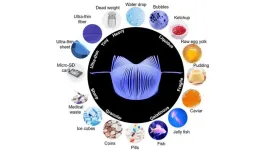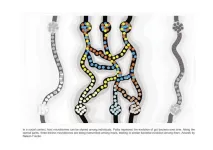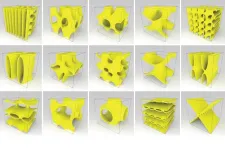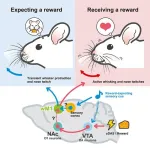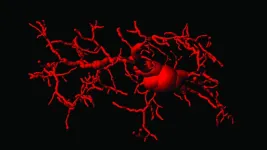(Press-News.org) Researchers at North Carolina State University have developed a robotic gripping device that is gentle enough to pick up a drop of water, strong enough to pick up a 6.4 kilogram (14.1 pound) weight, dexterous enough to fold a cloth, and precise enough to pick up microfilms that are 20 times thinner than a human hair. In addition to possible manufacturing applications, the researchers also integrated the device with technology that allows the gripper to be controlled by the electrical signals produced by muscles in the forearm, demonstrating its potential for use with robotic prosthetics.
“It is difficult to develop a single, soft gripper that is capable of handling ultrasoft, ultrathin, and heavy objects, due to tradeoffs between strength, precision and gentleness,” says Jie Yin, corresponding author of a paper on the work and an associate professor of mechanical and aerospace engineering at NC State. “Our design achieves an excellent balance of these characteristics.”
The design for the new grippers builds on an earlier generation of flexible, robotic grippers that drew on the art of kirigami, which involves both cutting and folding two-dimensional sheets of material to form three-dimensional shapes.
“Our new grippers also use kirigami, but are substantially different, as we learned a great deal from the previous design,” says Yaoye Hong, co-author of the paper and a recent Ph.D. graduate from NC State. “We’ve been able to improve the fundamental structure itself, as well as the trajectory of the grippers – meaning the path at which the grippers approach an object when grabbing it.”
The new design is able to achieve high degrees of strength and gentleness because of how it distributes force throughout the structure of the gripper.
“The strength of robotic grippers is generally measured in payload-to-weight ratio,” Yin says. “Our grippers weigh 0.4 grams and can lift up to 6.4 kilograms. That’s a payload-to-weight ratio of about 16,000. That is 2.5 times higher than the previous record for payload-to-weight ratio, which was 6,400. Combined with its characteristics of gentleness and precision, the strength of the grippers suggests a wide variety of applications.”
Another benefit of the new technology is that its attractive characteristics are driven primarily by its structural design, rather than by the materials used to fabricate the grippers.
“In practical terms, this means that you could fabricate the grippers out of biodegradable materials, such as sturdy plant leaves,” says Hong. “That could be particularly useful for applications where you would only want to use the grippers for a limited period of time, such as when handling food or biomedical materials. For example, we’ve demonstrated that the grippers can be used to handle sharp medical waste, such as needles.”
The researchers also integrated the gripping device with a myoelectric prosthetic hand, meaning the prosthesis is controlled using muscle activity.
“This gripper provided enhanced function for tasks that are difficult to perform using existing prosthetic devices, such as zipping certain types of zippers, picking up a coin, and so on,” says Helen Huang, co-author of the paper and Jackson Family Distinguished Professor in the Joint Department of Biomedical Engineering at NC State and the University of North Carolina at Chapel Hill.
“The new gripper can’t replace all of the functions of existing prosthetic hands, but it could be used to supplement those other functions,” Huang says. “And one of the advantages of the kirigami grippers is that you would not need to replace or augment the existing motors used in robotic prosthetics. You could simply make use of the existing motor when utilizing the grippers.”
In proof-of-concept testing, the researchers demonstrated that the kirigami grippers could be used in conjunction with the myoelectric prosthesis to turn the pages of a book and pluck grapes off a vine.
“We think the gripper design has potential applications in fields ranging from robotic prosthetics and food processing to pharmaceutical and electronics manufacturing,” Yin says. “We are looking forward to working with industry partners to find ways to put the technology to use.”
The paper, “Angle-programmed tendril-like trajectories enable a multifunctional gripper with ultradelicacy, ultrastrength, and ultraprecision,” is published open access in the journal Nature Communications. The paper was co-authored by Yao Zhao and Yanbin Li, postdoctoral researchers at NC State; Joseph Berman, a Ph.D. student at NC State; and Yinding Chi, a former Ph.D. student at NC State.
The work was done with support from the National Science Foundation under grants 2005374 and 2221479.
-shipman-
Note to Editors: The study abstract follows.
“Angle-programmed tendril-like trajectories enable a multifunctional gripper with ultradelicacy, ultrastrength, and ultraprecision”
Authors: Yaoye Hong, Yao Zhao, Joseph Berman, Yinding Chi, Yanbin Li and Jie Yin, North Carolina State University; He (Helen) Huang, North Carolina State University and the University of North Carolina at Chapel Hill
Published: Aug. 2, 2023, Nature Communications
DOI: https://doi.org/10.1038/s41467-023-39741-6
Abstract: Achieving multicapability in a single soft gripper for handling ultrasoft, ultrathin, and ultraheavy objects is challenging due to the tradeoff between compliance, strength, and precision. Here, combining experiments, theory, and simulation, we report utilizing angle-programmed tendril-like grasping trajectories for an ultragentle yet ultrastrong and ultraprecise gripper. The single gripper can delicately grasp fragile liquids with minimal contact pressure (0.05 kPa), lift objects 16,000 times its own weight, and precisely grasp ultrathin, flexible objects like 4-?m-thick sheets and 2-?m-diameter microfibers on flat surfaces, all with a high success rate. Its scalable and material-independent design allows for biodegradable noninvasive grippers made from natural leaves. Explicitly controlled trajectories facilitate its integration with robotic arms and prostheses for challenging tasks, including picking grapes, opening zippers, folding clothes, and turning pages. This work showcases soft grippers excelling in extreme scenarios with potential applications in agriculture, food processing, prosthesis, biomedicine, minimally invasive surgeries, and deepsea exploration.
END
Previous studies in humans and animals showed that hosts in a social condition (sharing the same space) harbor a more similar microbiota composition. Microbial transmission between hosts, which is increased when living in the same household, leads to similar species inhabiting the gut. However, whether bacterial evolution in the gut is affected by microbiota transmission remained unknown.
To fill this knowledge gap, the researchers used an innovative in vivo experimental evolution approach, which revealed an average transmission rate ...
‘A place for everything and everything in its place’–making sense of order, or disorder, helps us understand nature. Animals tend to fit nicely into categories: Mammals, birds, reptiles, whatever an axolotl is, and more. Sorting also applies to materials: Insulator, semiconductor, conductor, and even superconductor. Where exactly a material lands in the hierarchy depends on a seemingly invisible interplay of electrons, atoms, and their surroundings.
Unlike animals, the boundaries are less sharp, and tweaking a material’s ...
Engineers are constantly searching for materials with novel, desirable property combinations. For example, an ultra-strong, lightweight material could be used to make airplanes and cars more fuel-efficient, or a material that is porous and biomechanically friendly could be useful for bone implants.
Cellular metamaterials — artificial structures composed of units, or cells, that repeat in various patterns — can help achieve these goals. But it is difficult to know which cellular structure will lead to the desired properties. Even if one focuses on structures made of smaller building blocks like interconnected beams or ...
The world’s largest linked research database, Dimensions, will grow its knowledge base even further, thanks to a new partnership with the world’s largest university press, Oxford University Press (OUP).
Under the agreement, more than 27,000 books and 500 journal titles from OUP’s Oxford Academic digital publishing platform will be fully indexed and discoverable in Dimensions, adding another rich resource of academic material to the world’s largest research database, in fields such as the arts, humanities, economics, science, technology, history, and politics.
The move will enable users of Dimensions – a flagship Digital Science product – ...
3D light sculptures. Tsunami waves on a beach. Previewing color tattoos. Contributions from the Bickel and Wojtan groups at the Institute of Science and Technology Austria (ISTA) to the 2023 SIGGRAPH conference tackle an impressive variety of classic and novel questions. While their focuses range from computer graphics to fabrication methods, the computer scientists are united in finding cost-effective, innovative solutions and empowering users.
SIGGRAPH is the top worldwide annual convention for computer graphics and interactive techniques, bringing ...
One of the beneficial gut bacteria residing in the human gut, which normally cannot survive in an environment with oxygen, can now be made oxygen-tolerant. This is a key finding in the development of future probiotic treatment that is now being explored to improve glucose control in individuals with prediabetes.
Our intestines are home to trillions of bacteria, the gut microbiota, which are important for functions such as digesting food and educating and activating the immune system. During the past decade it has been clarified that changes in the bacterial composition can be linked to various diseases.
Significant expectations have been attributed to the next generation ...
CLEVELAND, Ohio (August 2, 2023)—Not all women experience menopause the same way. The severity of menopause symptoms is influenced by a multitude of behavioral, biological, social, psychological, and demographic factors. A new study suggests that infertility may also be a risk factor for some menopause symptoms, including depressive mood, irritability, and sleep problems. Results of the study are published online today in Menopause, the journal of The Menopause Society.
A woman’s reproductive history has been implicated as a factor in the timing of menopause onset and the prevalence of menopause ...
In animals, movements such as locomotion or grooming are known to influence neuronal activity within the cerebral cortex. Moreover, recent studies also suggest that these changes in neuronal activity are not confined to a specific area but are pervasive throughout cortical and subcortical regions of the brain. Interestingly, in animals trained for reward-based learning tasks, such spontaneous movements—despite being uninstructed and unnecessary—may be aligned to task events and may significantly contribute to ...
As we age, our bodies undergo various changes that can impact our overall health and make us more susceptible to diseases. One common factor in the ageing process is low-grade inflammation, which contributes to age-related decline and impairment. However, the precise pathways responsible for this inflammation and their impact on natural ageing have remained elusive until now.
A new study led by Andrea Ablasser at EPFL now shows that a molecular signaling pathway called cGAS/STING, plays a critical role in driving chronic inflammation and functional decline during aging. By blocking the STING protein, the researchers were able to suppress inflammatory responses in senescent ...
Cancer research centers conducting clinical trials could enroll more patients from underrepresented racial and ethnic groups by placing greater emphasis on relieving investigators of the costs of translating consent documents into languages other than English, according to a UCLA Jonsson Comprehensive Cancer Center study.
“We identified a readily addressable weakness in the clinical trial process, and we believe that overcoming this barrier, as we have begun to do, will ensure better representation of trial participants from traditionally underrepresented racial and ethnic groups, ...
